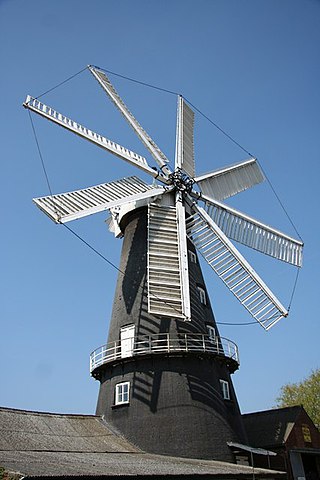
Heckington Windmill is the only eight-sailed tower windmill still standing in the United Kingdom with its sails intact.

The Town of East Hampton is located in southeastern Suffolk County, New York, at the eastern end of the South Shore of Long Island. It is the easternmost town in the state of New York. At the time of the 2020 United States census, it had a total population of 28,385.
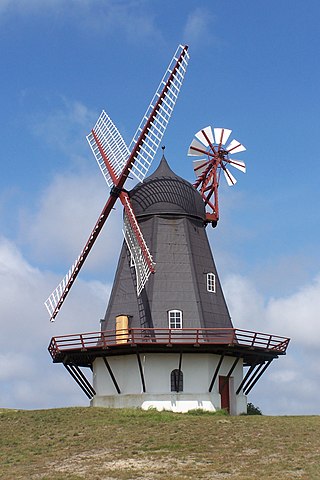
The smock mill is a type of windmill that consists of a sloping, horizontally weatherboarded, thatched, or shingled tower, usually with six or eight sides. It is topped with a roof or cap that rotates to bring the sails into the wind. This type of windmill got its name from its resemblance to smocks worn by farmers in an earlier period.
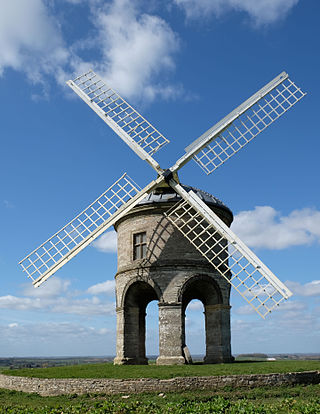
Chesterton Windmill is a 17th-century cylindric stone tower windmill with an arched base, located outside the village of Chesterton, Warwickshire. It is a Grade I listed building and a striking landmark in south-east Warwickshire.

Mulford Farm in East Hampton, Long Island, New York, is one of America's most significant, intact English colonial farmsteads. The farmhouse was built in 1680 by High Sheriff Josiah Hobart, an important early official of the first New York Royal Province government. Samuel "Fish Hook" Mulford bought the property in 1712 after Hobart's death. He had the barn built in 1721. The property is listed as a contributing property of the East Hampton Village District, a historic district listed on the National Register of Historic Places.

Gardiners Island Windmill is a historic windmill on Gardiners Island in East Hampton, New York. The mill was added to the National Historic Register in 1978.

Hayground Windmill is an historic windmill at Windmill Lane in East Hampton Village, New York. It was moved from Hayground to Pantigo between Two Mile Hollow Beach and Egypt Beach in the 1950s.

Beebe Windmill is a historic mill located at the southeast corner of Ocean Road and Hildreth Avenue in Bridgehampton, New York.

Shelter Island Windmill is an historic windmill north of Manwaring Road in Shelter Island, Suffolk County, New York. It was built in 1810. Master Millwright Nathaniel Dominy V (1770–1852) was the architect and builder of the windmill. The windmill has been on Shelter Island since 1840 and at its current location since 1926 on the Sylvester Manor farm.

Hook Windmill, also known as Old Hook Mill, is a historic windmill on North Main Street in East Hampton, New York. It was built in 1806 and operated regularly until 1908. One of the most complete of the existing windmills on Long Island, the windmill was sold to the town of East Hampton in 1922. The building was listed on the National Register of Historic Places in 1978 and is part of the North Main Street Historic District. The mill was renamed the "Old Hook Mill" and is open daily to visitors.

Corwith Windmill at Water Mill is a historic mill on NY 27 and Halsey Lane in Southampton, New York.

Clavering Windmills are a pair of Grade II listed Tower mills in Clavering, Essex, England. They have both been converted to residential use. They are named North Mill and South Mill. A third mill existed in Clavering until the mid-nineteenth century, known as Clavering Mill.

East Hampton Village District is a historic district in East Hampton, New York.
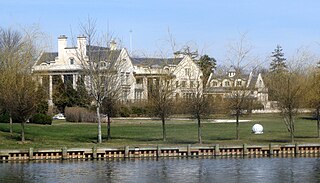
Villa Maria is an estate in Water Mill, New York. Built as a private residence in 1887, the villa itself was extensively remodelled by Brooklyn-based architect Frank Freeman in 1919. It later became a convent and spirituality center, before recently becoming a private residence once again. The building is considered a Long Island landmark.
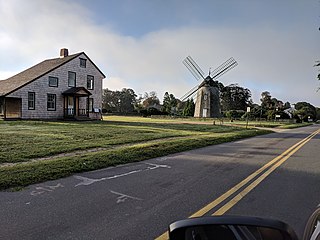
The mill cottage on the Lion Gardiner farm at 36 James Lane on the landmarked East Hampton Village green has become a museum displaying 19th and early-20th-century landscape paintings. It is a contributing structure on the NRHP East Hampton Village District, replacing the original cottage on the lot situated with the windmill and Rev James historic marker.
The Dominy craftsmen were a family made up of American clock, furniture, and watch makers in East Hampton, New York. Nathaniel Dominy IV, his son, Nathaniel V, and his grandson, Felix Dominy were active from about 1760 to 1840. Works created by the Dominys are in the collections of Winterthur Museum, Garden, and Library. As of 2022, a museum dedicated to the Dominys is under construction in East Hampton.
The Tide Mill at Southold, erected in the 1640's by Thomas Benedict, holds a place of distinction in American history as the first recorded English mill in the New World. It paved the way for future tide mills and contributed to the economic growth of the Southold community..
The Amagansett Mill Company (1829–1841) was an American company in Amagansett, New York. The windmill that it operated burned down in 1924.
Samuel Schellinger, was a millwright of Amagansett, New York and the craftsman who built the Pantigo windmill (1804), the Hayground Windmill (1809), the Amagansett windmill (1814) and the Beebe Windmill (1820) which are on the NRHP. Later, he built the Setauket windmill. Records show he built or worked on seven windmills and repaired others.





















